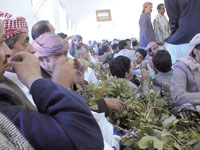
Local tourism faces many obstacles [Archives:2007/1076/Culture]
August 13 2007
 |
For Yemen Times
SANA'A, August 7– A recently conducted study revealed that there are a number of obstacles that hinder local tourism in Yemen, including qat consumption, lack of public facilities, such as restaurants and public bathrooms, on long roads, weak public awareness regarding the socio-economic advantages of tourism and lack of public support.
The findings of the study revealed a connection between income and the weak awareness of tourism's importance, as they are the key reasons behind the hindering of internal tourism.
The study was conducted by 36 researchers and included responses from roughly 5,800 surveys conducted throughout the Yemeni governorates according to governorate populations in light of the 2004 census. Survey samples were distributed based on age categories, with respondents aged 26-35 accounting for 46.9 percent, those 17-25 accounting for 40.5 percent and those respondents 36 and over accounting for 12.6 percent.
The findings of the study mentioned that most of the surveyed individuals stressed the importance of tourism as one of the ways to renew tourist activities in Yemen. Respondents fit into two groups. The first group indicated the necessity of tourism with a percentage of 49 percent. However, the second group was less than the first with 44.4 percent.
The remaining group responses varied, indicating the importance of finding various tourist programs reflecting the desire of the targeted categories.
Respondents' view regarding the role of the media in introducing tourist sites as well as internal tourism in Yemen ranged between 7.6 percent selecting nothing, 35.4 percent selecting weak, 25.9 percent selecting fair, 24.3 percent selecting good and 6.8 percent selecting very good.
The above indicators affirmed the weak role of the media in generating internal tourism. The media presents inadequate and unorganized information regarding tourism. This stresses the necessity of evaluating the role of the media and emphasizes the importance of preparing media tourist programs to educate people about the importance of tourism.
Moreover, the outcomes of the survey mentioned that most individuals prefer natural tourism (52.8 percent), whereas, entertainment tourism garnered 27.5 percent and cultural tourism formed 15.9 percent. The remaining 3.8 percent was distributed on other categories of tourist activity, such as medical, religious, etc.
The study also revealed that most of the surveyed individuals do not allocate a specific amount of their income for tourism, representing 55.5 percent. However, 12.7 percent save 10,000 Yemeni riyals and 4.5 percent set aside 5, 000 Yemeni riyals for tourism. These outcomes reflect that a large number of individuals have no investment in tourism, money which could be used to design more suitable and interesting programs to draw tourist revenue.
The study also mentioned that there are several reasons that prevent citizens from bringing their families to tourist sites. It indicated that 47.4 percent have no special family places and 29.1 percent said that there are some disturbances in such places. Another 32 percent attributed certain social reasons to the hindrance of citizen tourism participation.
These responses emphasize the importance of specifying particular places for families as well as the importance of hiring tourist police to protect families from annoyances encountered while visiting tourist attractions.
The findings of the study indicated that most of the surveyed individuals prefer furnished hotels and flats. 21.1 percent prefer five star hotels and 10.3 percent like to stay in first-class furnished flats. However, 9.4 percent prefer to stay in three star hotels and 9.1 percent prefer five star tourist villages. The remaining proportions were distributed among other classes of accommodation.
The study also showed that the areas that receive the biggest share of tourist activity are coastal areas with 48.3 percent followed by archeological sites at 25.5 percent. The protectorates garnered 10 percent and the mountainous regions formed 4.1 percent. This gives a good indication of the most popular tourist programs as well as the sites that may need a little more exposure.
The survey findings stated that there are several causes that hinder citizens from visiting tourist sites, particularly archeological and historical sites. One of the most prominent factors is low income with 18 percent of respondents highlighting this fact. This stresses the importance of taking citizens' income into consideration while conducting tourist programs. The lack of asphalted and paved roads, which lead to tourist archeological sites stood at 13 percent. Absence of media exposure formed 11.6 percent whereas disturbances faced by the visiting families came in at 9.5 percent. Lack of cleanliness and lack of tourist guides was also mentioned by 8.6 and 8.3 percent of respondents respectively. Lack of tourist security and safety was mentioned by 8.2 percent and 8 percent indicated poor service of hotels and restaurants. Absence of monitoring tourist services formed 6.6 percent of responses while 6.1 percent of respondents claimed a lack of time to visit such tourist spots.
——
[archive-e:1076-v:15-y:2007-d:2007-08-13-p:culture]


